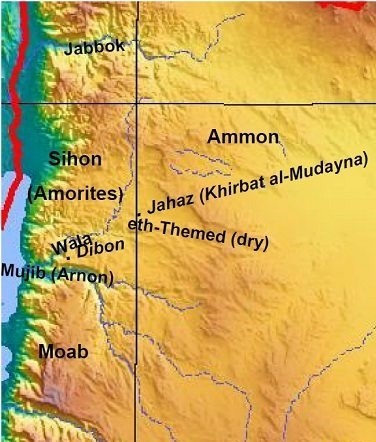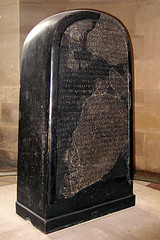 Edit article
Edit articleSeries
War at Yahatz: The Torah Versus the Mesha Stele

כי ארנון גבול מואב – Wadi Mujib, View to southwest. (Wikimedia)
We meet Sihon, king of the Amorites, and read details of the Israelites’ encounter with him, in three places:
- Numbers 21:21–30 narrates his encounter with Israel when it is purported to have transpired.[1]
- In Judges 11:19–22 (the haftarah for Parashat Chukkat), Jephthah the Gileadite cites this encounter in his “history lesson” to the king of the Ammonites.
- In Deuteronomy 2:24b–36, Moses tells the story retrospectively, in the first person.
Although these stories differ, their basic message is the same: the Israelite camp sends a delegation to the Amorite king Sihon to ask permission to pass though his country. Sihon refuses, and gathers his army to war against Israel. The battle is waged at Yahatz (יהץ); Israel prevails, and takes possession of Sihon’s land.
What is the significance of this story? As a historical geographer, I will focus on a geographical point, and see what this angle can teach us about the story and its meaning.[2]
The Border between Sihon’s Amorite Kingdom and Moab
Before Israel sends messengers to Sihon to request that he allow them to pass through his territory, the Torah clarifies the exact border between the (southern) territory of the Moabites and the (northern) territory of the Amorites.[3]
במדבר כא:יג מִשָּׁם נָסָעוּ וַיַּחֲנוּ מֵעֵבֶר אַרְנוֹן אֲשֶׁר בַּמִּדְבָּר הַיֹּצֵא מִגְּבוּל הָאֱמֹרִי כִּי אַרְנוֹן גְּבוּל מוֹאָב בֵּין מוֹאָב וּבֵין הָאֱמֹרִי.
Num 21:13 From there they set out and encamped beyond the Arnon, that is, in the wilderness that extends from the territory of the Amorites. For the Arnon is the boundary of Moab, between Moab and the Amorites.

Having clarified the border between Moab and the Amorites, the Torah takes the unusual step of buttressing its claim with a proof text from The Book of the Wars of YHWH:
במדבר כא:יד-טו עַל כֵּן יֵאָמַר בְּסֵפֶר מִלְחֲמֹת יְהוָה אֶת וָהֵב בְּסוּפָה וְאֶת הַנְּחָלִים אַרְנוֹן. וְאֶשֶׁד הַנְּחָלִים אֲשֶׁר נָטָה לְשֶׁבֶת עָר וְנִשְׁעַן לִגְבוּל מוֹאָב.
Num 21:14-15 Therefore, the Book of the Wars of YHWH speaks of “Waheb in Suphah, and the wadis: the Arnon with its tributary wadis, stretched along the settled country of Ar, hugging the territory of Moab.”
The main point of this quotation is to support the assertion that Wadi Arnon is the northern border of Moab.[4]
The Arnon border is mentioned yet again when the Torah describes the earlier war of conquest that Sihon waged against Moab in the first place ().
במדבר כ:כו...וְהוּא נִלְחַם בְּמֶלֶךְ מוֹאָב הָרִאשׁוֹן וַיִּקַּח אֶת כָּל אַרְצוֹ מִיָּדוֹ עַד אַרְנֹן
Num 21:26 ...He had fought against a former king of Moab and taken all his land from him as far as the Arnon.
Certainly these accounts want to emphasize where the northern border of Moab and the southern border of Sihon’s Amorite kingdom lies, and that this area belonged to the Amorites (and not the Moabites!). After the Israelites vanquish the Amorites in battle, the Israelites appropriate this land as their own.
The Border between Sihon’s Amorite Kingdom and Ammon
Borders come up again during the account of the war between Israel and Sihon, this time clarifying the northern border of Sihon’s territory and, more importantly, its eastern border which is the western border of Ammonite territory:
במדבר כא:כד וַיַּכֵּהוּ יִשְׂרָאֵל לְפִי חָרֶב וַיִּירַשׁ אֶת אַרְצוֹ מֵאַרְנֹן עַד יַבֹּק עַד בְּנֵי עַמּוֹן כִּי עַז גְּבוּל בְּנֵי עַמּוֹן.
Num 21:24 But Israel put them to the sword, and took possession of their land, from the Arnon to the Jabbok, as far as the Ammonites,for the boundary of the Ammonites was strong.
Numbers is emphasizing the precise borders of Sihon’s territory just as it did with that of Moab.
The War in Yahatz: The Bible Versus the Mesha Stela
According to the biblical text, Sihon places his army in the vicinity of Yahatz, and from there wages his war against the Israelites:
במדבר כא:כ וַיֶּאֱסֹף סִיחֹן אֶת כָּל עַמּוֹ וַיֵּצֵא לִקְרַאת יִשְׂרָאֵל הַמִּדְבָּרָה וַיָּבֹא יָהְצָה וַיִּלָּחֶם בְּיִשְׂרָאֵל.
Num 21:20 Sihon gathered all his people and went out against Israel in the wilderness. He came to Yahatz and engaged Israel in battle.
The Israelites win this battle and the tribe of Reuben settled the area. This very city is mentioned in the famous Mesha Stela, which dates to the 9th century B.C.E. and records the success of the Moabite king, Mesha, against a descendent of the Israelite king, Omri (presumably Ahab). As part of the description of his success, Mesha explains the background for the war between Moab and the Northern Kingdom of Israel:
וּמֶלֶךְ יִשְרָאֵל בָּנָה אֶת יַהַץ וַיֵשֶב בָּה בְּהִלְתָחֲמֹה בִּי וַיְגַרְשֵהֻ כְּמֹש מִפָּנַי. וָאֶקַח מִמֹאָב מָאתֵן אִש כָּל רָשֵהֻ וָאֶשָאֵהֻ בְּיַהַץ וַאֹחֲזֶהָ לָסֶפֶת עַל דִיבֹן.[5]
Now the king of Israel had built Yahatz, and he occupied it while he was fighting against me. But Kemosh drove him out from before me. I took from Moab two hundred men, its entire unit. I took it up against Yahatz and captured it to annex (it) to Daibon.[6]

According to Mesha, Yahatz is a Moabite town that was captured by the king of Israel (Ahab or Omri), who then built it up, and the city is subsequently retaken by Mesha. How might we reconcile this document with the tradition that Israel already took this town much earlier, in the wilderness period?
Although it possible that possession of Yahatz seesawed back and forth between Israel and its neighbors,[7] I would suggest that the Sihon account is not historical, but is a story designed to solidify Israel’s claim on its Transjordanian holdings. In her,“Inventing the Mythic Amorite Kingdom of Sihon,” (TheTorah.com 2015) Rachel Havrelock, suggests that Sihon and his Amorite kingdom were invented to protect the Israelites from the accusation that they attacked the Moabites directly (or perhaps worse that they are Moabites who changed allegiance and became Israelites). I am not sure I would go that far, but irrespective of whether there ever was an Amorite kingdom of Sihon, the Torah was never primarily concerned with the real borders of the Amorites. Instead, it was concerned with clarifying the border between the “former kingdom of Sihon,” i.e. Israel’s Transjordanian holdings, and Moab.

Since Yahatz appears to be the focus of the border dispute between Moab and the Northern Kingdom of Israel, I suggest that the question was whether the boundary between the kingdoms was at Wadi Mujib (=Wadi Arnon), which would maximize Israel’s holdings, or in its northern tributary, Wadi eth-Themed (a dry river bed then and now), which reaches as far north as Yahatz and would maximize Moab’s holdings. The focus on a small detail such as which wadi forms the proper border between Moab and Israel may feel irrelevant to modern readers, but for those who lived in the area between the two tributaries and for the kingdoms that claimed to rule the territory (Moab and Israel), it was very relevant.[8]
A Dispute of Northern-Israelite Interest Only
This border dispute between Mesha and the Northern Kingdom of Israel is recorded independently in the Torah and the Mesha Stela, and perhaps in a lost third source, The Book of the Wars of YHWH, quoted in Numbers.
I believe that although this border dispute has been projected back to the wilderness period, the authors of this original text are in the heat of this dispute and are responding to a current political conflict. I would argue that the story from Numbers comes from the Northern E (Elohist) source,[9] compiled in the Northern Kingdom of Israel. This source often features Transjordanian characters, like Reuben (in the Joseph story)[10] and the Reubenite rebels Datan and Abiram (parts of Num 16), as well as a detailed discussion about how the Israelites settled in the Transjordan (parts of Num 32).[11]
It is perfectly natural that both the Israelites and the Moabites would wish to record the details of the borders and battles between their Transjordanian polities. The Mesha inscription, written on behalf of the Moabite king, deals with this issue from a Moabite perspective. The Book of the Wars of YHWH and the biblical texts about Sihon deal with it from an Israelite perspective.
Thus did a border squabble between Moab and the Northern Kingdom of Israel make it into the Torah, even bringing about the preservation of a quote from the lost Book of the Wars of YHWH. While the Torah put in great effort to use Sihon and his Amorite kingdom to hide the border dispute with Moab by burying it in the past, comparison with the Mesha Stele allows us to uncover the underlying contemporary issues that the authors of the Sihon account were addressing.
TheTorah.com is a 501(c)(3) nonprofit organization.
We rely on the support of readers like you. Please support us.
Published
July 23, 2015
|
Last Updated
November 11, 2025
Previous in the Series
Next in the Series
Before you continue...
Thank you to all our readers who offered their year-end support.
Please help TheTorah.com get off to a strong start in 2025.
Footnotes

Dr. David Ben-Gad HaCohen (Dudu Cohen) has a Ph.D. in Hebrew Bible from the Hebrew University. His dissertation is titled, Kadesh in the Pentateuchal Narratives, and deals with issues of biblical criticism and historical geography. Dudu has been a licensed Israeli guide since 1972. He conducts tours in Israel as well as Jordan.
Essays on Related Topics:









